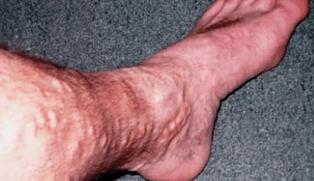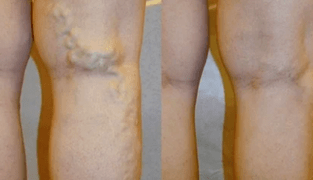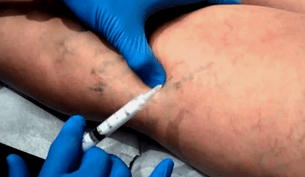According to statistics, varicose veins on the legs are about three times less common in the stronger sex than in women. Even so, everyone is susceptible to this disease, including men.
According to phlebologists and vascular surgeons, there are no fundamental differences between varicose veins in men and women. Unfortunately, the former do not seek help until much later, when the disease has developed and is much less treatable. The article focuses on the features of the course of the disease in men, as well as methods of dealing with it.
The influence of heredity and bad habits on the development of varicose veins
First of all, it should be understood that varicose veins or varicose veins are referred to in medical practice as a pathology that is associated with a deformation of the venous vessels. In this case, the latter expand, expand, their walls become thinner, and the valve system no longer performs its functions. The consequences of the progression of the pathological process are as follows:

- A stagnation of the blood in the veins increased the venous pressure.
- A violation of the blood circulation is accompanied by a deterioration in the lymph flow.
- Vascular lumps, also called spider veins, appear.
- vascular rupture and the appearance of hematomas.
- Occurrence of trophic ulcers.
- Increased risk of thrombophilia.
When studying the etiology of varicose veins, doctors have come to the conclusion that the disease is more likely to develop due to a genetic predisposition. However, the hereditary factor does not affect the varicose veins themselves, but is a predisposition to weakness of the valve system, as a result of which the venous valves become weaker and wear out more quickly. This process is the cause of impaired blood circulation in the vascular bed and, as a result, the development of obstruction, deformation of the veins, that is, the very spasmodic veins.
In addition, bad habits, which list smoking and alcohol first, play an important role in patient medical history. The abuse of tobacco and alcohol products negatively affects the functioning of the cardiovascular system, as well as the condition of blood vessels and even blood composition. Referring back to the hard statistics, both habits are more likely to be men. Because of this fact, smoking and alcohol addiction are high on the list of reasons behind the development of varicose veins.
The two reasons described are not the only ones. There are several other factors considered most likely in the list of causes of pathology:
- Excessive stress on the legs from professional activities (cooks, surgeons, etc. ), obesity, excessive physical exertion due to sport or the same professional activities (loaders, builders, etc. );
- The medal has a disadvantage, varicose veins can be triggered by a lack of exertion or rather by a sedentary or simply sedentary lifestyle. If we proceed from this point of view, drivers, office workers, and people who do little exercise for other reasons, including unwillingness, are susceptible to the disease.
- Taking into account smoking and hereditary predisposition, various diseases in which blood clotting is impaired are one of the most serious and very common causes.
Hormonal disorders, wearing uncomfortable shoes and similar factors are more common in women. For the same reasons (due to the larger number of triggers), the fair sex is more likely to suffer from varicose veins.
The main symptoms of varicose veins
When it comes to the clinical picture of the disease, much depends on the stage of its progression, as well as a number of individual factors and causes of varicose veins. However, there are a number of symptoms that are most common in men:

- The initial stage of the development of varicose veins rarely bothers the patient. There may be slight tiredness in the legs, worse in the evening, feelings of pulling or squeezing, slight swelling. In most cases, men do not pay attention to such phenomena and in vain, as the disease progresses, and over time the symptoms become stronger and cause more problems.
- In the course of the pathological process, veins appear under the skin. These are initially vascular networks and separately protruding enlarged veins, which are then supplemented with vascular asterisks. The further the disease develops, the more obvious this clinical sign becomes. In the later stages of the development of the disease, the veins under the skin bulge, form nodules, and the risk of trophic ulcers increases.
- Unpleasant feelings of bursting, a feeling of heaviness in the legs and swelling that previously appeared in the late afternoon or at the end of the work day are becoming more and more noticeable. Over time, the symptoms develop into systematic pain that spreads through the vessels affected by varicose veins.
- In places where enlarged veins and vascular networks are clearly visible, itching occurs on the skin.
- Cramps, which mostly affect the foot or calf muscles, can also be a nuisance at night.
Important to note!All of the described clinical signs of varicose veins tend to increase in the evening, but this is precisely due to fatigue. That is, the symptoms become more intense even with increased physical exertion.
Stages of venous disease in men
As already mentioned, the symptoms and also the state of health of the patient and the methods of treatment for varicose veins depend heavily on the degree of progression of the disease. In total there are three stages in the development of pathology:
- Balancing or mild- in this case the symptoms are the least intense and the patient himself practically does not complain about anything. Even in the first stage, slightly protruding vessels can appear on the legs, but men do not pay attention to this.
- Medium- This stage of the disease is also known as subcompensatory. Veins are more clearly visible on the surface of the skin, but their enlargement and deformation can still be considered small, as can the pressure in the vessel. At this stage, other symptoms intensify, edema, fatigue and painful sensations appear for the first time.
- Decompensation stage- the most severe form when varicose veins reach their peak. You notice severe swelling, severe pain, which can bother you throughout the day, veins protrude strongly on the surface of the skin and change. At this stage, vascular nodes are formed, excessively increased vascular pressure leads to damage to the walls of the veins, and hematomas appear. In particularly advanced cases, trophic ulcers and eczema appear. In the third phase, conservative treatment methods are absolutely powerless. The patient needs surgical intervention, the specificity of which is selected by the doctor.

Treatment of varicose veins
As with symptoms, the principles of treatment depend directly on how far the varicose veins have progressed. It is important to understand that conservative therapy mainly bears fruit in the first, sometimes second stage of the development of the disease, otherwise the methods of conservative treatment will predominantly inhibit the disease, but will not provide an opportunity to completely get rid of varicose veins. Still, it is worth considering a wide range of methods for dealing with pathology.
Conservative Therapy
For treatment with conservative methods, an integrated approach is very important, which primarily implies changes in diet and lifestyle changes.
In terms of diet, it is important to limit the use of junk food, fatty and fried foods, as well as sweets in large quantities, to minimize salty, spicy and acidic foods, as all of these contribute to fluid retention in the body and increase lymph flowimpaired.If you want to adjust your lifestyle, you should try to move as much as possible without overloading your legs. Do light sports, take regular walks, if you have to sit a lot at work, warm up every hour. It is also very important to rule out bad habits, quit smoking and limit alcohol consumption as much as possible.
drug therapy
Complete treatment is not possible without the use of certain drugs. Therefore, upon contacting a phlebologist, a specialist can prescribe medicines from the following groups:
- Anticoagulants - change the composition of blood, reduce its viscosity, improve blood circulation and prevent the formation of stagnation of blood and lymph.
- Venotonics - As the name suggests, drugs of this group improve vascular tone. In turn, it helps to improve blood circulation, but is based on a different principle of action.
- As a symptomatic treatment, ointments from the category of NSAIDs are prescribed, which reduce painful sensations and stop the inflammatory process. In addition, special ointments for varicose veins are prescribed to get rid of edema and other symptoms.
- As part of conservative treatment, it is also necessary to wear compression underwear to prevent varicose veins from progressing and to improve the patient's condition in general.
Surgical treatments
If conservative treatment does not produce the desired results or the disease has progressed too far, a decision about surgical intervention will be made. In this case, one of the types of operations is selected:

- Sclerotherapy- A substance (usually in the form of foam) is injected into the vein, which sticks up the walls of the vessel and keeps it out of the bloodstream. Over time, this vessel removes itself and is replaced by connective tissue.
- Phlebectomy- a full-fledged operation in which the anastomosis of a vein is clamped and the affected area is then removed. This method is the most effective and, at the same time, the most radical, as it includes a cut, the imposition of words and a long period of rehabilitation.
- Miniflebectomy- a variation of phlebectomy that is mainly performed on small vessels. A puncture is made in the skin through which part of the vein is pulled out with a special surgical instrument for subsequent dissection. The operation is painless, the puncture heals quickly, and no rehabilitation is required.
- Laser coagulation- a method similar to sclerotherapy, but instead of introducing a special composition into the lumen of a vessel, a thin catheter is inserted there with a laser. The thermal effect creates a sclerosis effect that also sticks the vessel together.

























